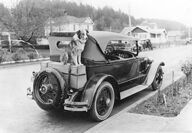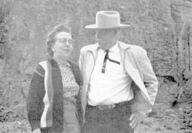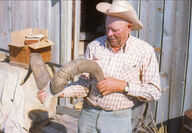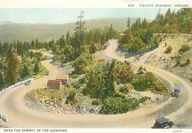Sorted by date Results 26 - 42 of 42

In the summer of 1981, a little action-adventure movie titled Raiders of the Lost Ark came out, and fans have been speculating ever since on whom the character of Indiana Jones might be based. The most popular speculation — Vanity Fair magazine goes so far as to opine that he is “almost certainly” the basis for Jones — is Roy Chapman Andrews, a globe-trotting paleontologist and former director of the American Museum of Natural History. Well, the fact is that Jones probably wasn’t based on...

Up until his untimely death from a fall in 1937, Rogue River Wilderness mountaineer and mule-train driver Hathaway Jones enjoyed a reputation as the “damnedest liar” in all the West Coast states and probably a couple dozen inland ones too. And he was proud of that reputation. When the Portland Morning Oregonian referred to another backwoods character as the “biggest liar in the country,” Hathaway claimed he was going to sue the paper for defamation. (As a side note, that competitor for the “bi...

Part Two: Legendary raconteur Reub Long, the “Sage of Fort Rock,” packed a whole lot into his 76 years living in central Oregon. Most of it — though by no means all — had to do with horses. “The ranch I have and the things I’ve done were due to horses,” he wrote in his book. “I had workhorses for hire by contractors for freighting, haying, or construction jobs; I owned riding and pack horses for running dude outfits in the mountains; I raised riding horses to sell; I supplied bucking horses...

The tiny town of Fort Rock, Oregon, is famous for two things: The 14,000-year-old sandals found in a cave nearby, and Reub Long. It’s been a while — nearly 50 years since Reub died at age 76, in the summer of 1974. But even today, among old Oregon wits and raconteurs and cowboy poets, Reub plays number two to nobody. Perhaps Stewart Holbrook could have given him a run for the money; but Holbrook was a journalist, so his storytelling was constrained by a sense of duty to stick mostly to the fac...

Part Three “KLONDIKE KATE” ROCKWELL had visited Central Oregon before, and been deeply impressed by the beauty of the high desert. Now it seemed like just the place to get away from all things Vaudeville, to forget Pantages, to re-center herself. And she had friends there — although actually, she had friends almost everywhere, among the former sourdoughs of the Klondike gold rush. And, the Oregon High Desert country at that time (circa 1910) was one of the last parts of the continental U.S....

Part Two Kathleen Eloise Rockwell was born in Kansas in 1876 and grew up in Spokane and Valparaiso, Chile. At age 18 she left home, moved to New York, and took a job as a chorus girl. It was the start of a lifelong career as a dancer on the Vaudeville scene. The turn of the century found Kate in Spokane again, working in a variety of theaters there. And that’s where she was when she heard about the Klondike gold rush. She was adventuresome, athletic, and young, and the Klondike offered her t...

Part One Imagine this story playing out on a television or movie screen near you (or a Vaudeville stage!): Fade in on a tall, rugged-looking woman in a bright-red “Sergeant Preston of the Yukon” outfit. We hear a voiceover from a gravel-voiced Narrator: Narrator: “It’s June of 1901. In the Territorial capital of Whitehorse, ‘Klondike Kate Ryan’ is the first woman officer in the history of the Royal North-West Mounted Police, a precursor agency to the famous Royal Canadian Mounted Police, a.k.a....

When Hasso Hering, the legendary longtime editor of the Albany Democrat-Herald, first came to Oregon in the mid-1960s, one of the things that struck him was the quality of the roads. “All the roads were wide and smooth and well built,” he said (or words to that effect; I don’t remember verbatim). “There were no potholes. You could go all day. You could drive your Mustang as fast as you wanted, and nobody would bother you. I’d never seen anything like it.” Oregonians of a certain age will know w...

Virgil settled down in Colton with Allie and tried to put down roots. He worked security for Wells Fargo & Co. — using a top-break revolver that he could reload one-handed — and opened a detective agency. Later he served as town constable and became famous for his even temper and his ability to de-escalate potentially deadly situations. His favorite less-than-lethal law enforcement technique, when force had to be used, was “buffaloing” — that is, pistol-whipping — unruly suspects. After the “ven...

Robert Franz came to the Illinois River Valley in 1921 for his health. Suffering from a degenerative lung disease — probably tuberculosis — he had been advised that moving into the Oregon wilderness, with its clean air and healthy climate, was his best shot at staying alive. That didn’t turn out to be true. To be fair, that wasn’t the climate’s fault — but I’m getting ahead of myself. Robert and his wife, Annanette Bruun Fantz, bought a big 72-acre piece of land on a natural terrace overl...

Signs and threats like the “COMITEE” warnings in the Klickitat Valley showed that this threat was being taken very seriously. Fortunately, though, the worst-case scenario was very rare. There were a few sheepherders who insisted on their right to plunder the public domain regardless of how the neighbors felt about it; but on the Western frontier, disagreements like this had a tendency to get worked out with fists and sometimes pistols. Overall, everyone grumbled, but they all managed to coe...

On September 14, 1964, the steamship Al Kuwait was moored at the dock in Kuwait City when something terrible happened: The ship capsized and settled to the harbor floor. This was bad enough news for the town by itself. But the real problem was, that Al Kuwait was a livestock transport freighter. It was full of sheep. Five thousand of them. These poor animals were, of course, drowned when the hull flooded. But then the carcasses started to decompose. This was an environmental disaster, because...

By On February 20, 1931, a former Lincoln County commissioner named Elmer Calkins looked behind his tractor at the plow he was pulling and saw human bones strewn out along the furrow behind it. Calkins was working up a patch of land near the mouth of the Salmon River so that it could be flattened out into a smooth, park-like landscape for the summer camping resort he was building there. The new Roosevelt Highway - Highway 101 - was mostly built, and car-tripping tourists from the Willamette...

It was the dark early-morning hours of Feb. 13, 1911, and off the north coast of Oregon the gasoline-powered motor schooner Oshkosh was in serious trouble. The Oshkosh was a coastwise cargo ship, but it wasn’t much bigger than a large yacht. It was 89 feet long and rated at just 145 tons. It was also nearly brand new, built in 1909 at the Kruse and Banks Shipyard in North Bend. The little freighter was only about a year and a half old. It would not see two. The Oshkosh had left Tillamook Bay a...
By Finn J.D. John Skeleton In a few weeks, the streets of Oregon will be thick with trick-or-treaters again. And although the hot costumes this year include zombies, pirates and Batman, there will probably be one or two kids out there dressed as skeletons. Skeletons may be out of fashion this year, but they’re arguably the most interesting Halloween artifact you could name. Skeletons are real; they’re dead, but were once alive; they can’t talk, but once could; and their cold and lifeless condition suggests that something dramatic, perha...
Reub and Eleanor Long Fort Rock’s legendary Reub Long could spin a wild yarn There was a time, and it was not too long ago, that the state of Oregon had something of a reputation as a place for great liars. Now, by “great liars,” I mean tellers of the GOOD kind of lies, not the kind of lies various politicians are throwing around right now. I’m talking about the “Paul Bunyan, Casey Jones and Pecos Bill” kind of liars. One such “great liar” of honored memory is a lively Eastern Oregon fellow named Reub Long.You may recognize Reub’s name if...
The World's largest log cabin; Lost in a 1964 fire" src="http://mckenzieriverreflectionsnewspaper.com/sites/default/files/images/Forestry-bldg-interior.png" style="width: 180px; height: 114px; border-width: 0px; border-style: solid; margin: 5px; float: left;" Oregon lost the world’s biggest log cabin in spectacular 1964 fire When the sun came up on the morning of August 17, 1964, Oregon was home of the world’s largest log cabin. When the sun went down that evening, it wasn’t — and firefighters were still battling a blaze that sent flame...